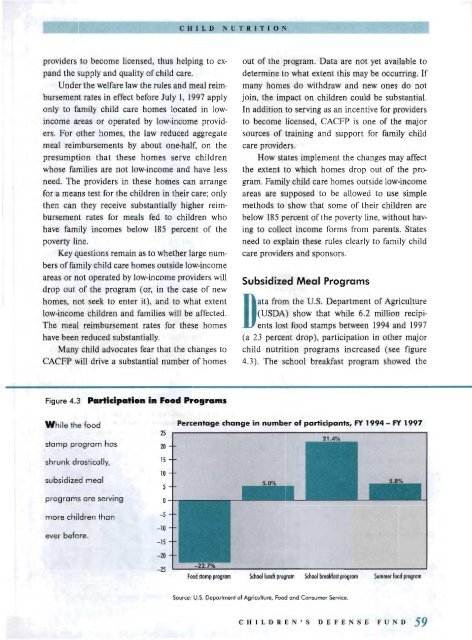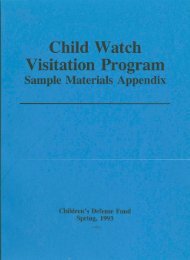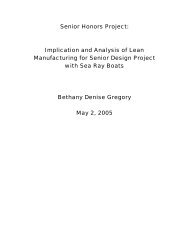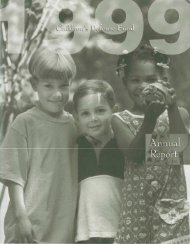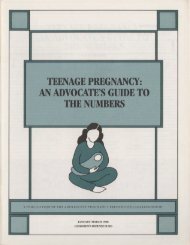child care - Digital Library Collections
child care - Digital Library Collections
child care - Digital Library Collections
You also want an ePaper? Increase the reach of your titles
YUMPU automatically turns print PDFs into web optimized ePapers that Google loves.
CHILD<br />
NUTRITION<br />
;;0".;'-'- ....<br />
providers to become licensed, thus helping to expand<br />
the supply and quality of <strong>child</strong> <strong>care</strong>.<br />
Under the welfare law the rules and meal reimbursement<br />
rates in effect before July I, 1997 apply<br />
only to family <strong>child</strong> <strong>care</strong> homes located in lowincome<br />
areas or operated by low-income providers.<br />
For other homes, the law reduced aggregate<br />
meal reimbursements by about one-half, on the<br />
presumption that these homes serve <strong>child</strong>ren<br />
whose families are not low-income and have less<br />
need. The providers in these homes can arrange<br />
for a means test for the <strong>child</strong>ren in their <strong>care</strong>; only<br />
then can they receive substantially higher reimbursement<br />
rates for meals fed to <strong>child</strong>ren who<br />
have family incomes below 185 percent of the<br />
poverty line.<br />
Key questions remain as to whether large numbers<br />
offamily <strong>child</strong> <strong>care</strong> homes outside low-income<br />
areas or not operated by low-income providers will<br />
drop out of the program (or, in the case of new<br />
homes, not seek to enter it), and to what extent<br />
low-income <strong>child</strong>ren and families will be affected.<br />
The meal reimbursement rates for these homes<br />
have been reduced substantially.<br />
Many <strong>child</strong> advocates fear that the changes to<br />
CACFP will drive a substantial number of homes<br />
out of the program. Data are not yet available to<br />
determine to what extent this may be occurring. If<br />
many homes do withdraw and new ones do not<br />
join, the impact on <strong>child</strong>ren could be substantial.<br />
In addition to serving as an incentive for providers<br />
to become licensed, CACFP is one of the major<br />
sources of training and support for family <strong>child</strong><br />
<strong>care</strong> providers.<br />
How states implement the changes may affect<br />
the extent to which homes drop out of the program.<br />
Family <strong>child</strong> <strong>care</strong> homes outside low-income<br />
areas are supposed to be allowed to use simple<br />
methods to show that some of their <strong>child</strong>ren are<br />
below 185 percent ofthe poverty line, without having<br />
to collect income forms from parents. States<br />
need to explain these rules clearly to family <strong>child</strong><br />
<strong>care</strong> providers and sponsors.<br />
Subsidized Meal Programs<br />
Data from the U.S. Department of Agriculture<br />
(USDA) show that while 6.2 million recipients<br />
lost food stamps between 1994 and 1997<br />
(a 23 percent drop), participation in other major<br />
<strong>child</strong> nutrition programs increased (see figure<br />
4.3). The school breakfast program showed the<br />
Figure 4.3<br />
Participation In Food Programs<br />
While the food<br />
stamp program has<br />
shrunk drastically,<br />
subsidized meal<br />
programs are serving<br />
more <strong>child</strong>ren than<br />
ever before.<br />
25<br />
20<br />
15<br />
10<br />
-5<br />
-10<br />
-15<br />
-20<br />
-25<br />
Percentage change in number of participants, FY 1994 - FY 1997<br />
Food stomp program 5dlOoilunch program 5


